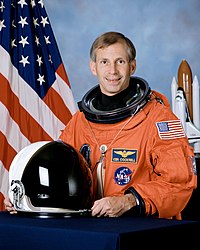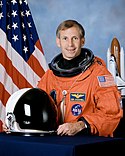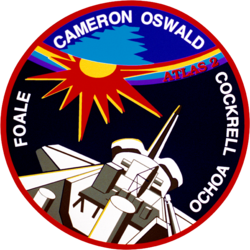Kenneth Cockrell
| Kenneth Cockrell | |
|---|---|
 | |
| Land: | USA |
| Organisation: | NASA |
| ausgewählt am | 17. Januar 1990 (13. NASA-Gruppe) |
| Einsätze: | 5 Raumflüge |
| Start des ersten Raumflugs: | 8. April 1993 |
| Landung des letzten Raumflugs: | 19. Juni 2002 |
| Zeit im Weltraum: | 64d 12h 25m |
| ausgeschieden am | Februar 2006 |
| Raumflüge | |
Kenneth Dale „Taco“ Cockrell (* 9. April 1950 in Austin, Texas, USA) ist ein ehemaliger US-amerikanischer Astronaut.
Leben
Geboren in der Hauptstadt des US-Bundesstaates Texas, wuchs Cockrell in der nahegelegenen Kleinstadt Rockdale auf. 1968 schloss er die High School ab und studierte zunächst an der University of Texas Maschinenbau. Nach seinem Bachelor-Diplom, das er im Jahr 1972 erwarb, ging er an die University of West Florida, wo er das Hauptfach Luftfahrttechnik belegte und 1974 einen Master erhielt. Cockrell trat in die US-Marine ein und wurde ab 1975 für drei Jahre als Marinepilot auf der A-7 „Corsair II“ auf den inzwischen ausgemusterten Flugzeugträger „USS Midway“ versetzt, dessen Route in den Indischen Ozean und den Westpazifik führte. In die USA zurückgekehrt, besuchte Ken die United States Naval Test Pilot School in Patuxent River (Maryland). Nach seiner Ausbildung 1979 blieb er dort bis zum Sommer 1982 als Testpilot. Es schlossen sich mehrere Jahre als Stabsoffizier der Kommandanten der Kampfeinheiten auf der „USS Ranger“ und der „USS Kitty Hawk“ an. 1985 wurde er wieder als Pilot (F/A-18 „Hornet“) eingesetzt und unternahm als Mitglied eines Kampfgeschwaders zwei Einsätze auf der „USS Constellation“.
Im Jahr 1987 verließ Cockrell den aktiven Militärdienst und nahm im November des Jahres eine Stelle als Luftfahrttechniker und Testpilot am Johnson Space Center (JSC) in Houston an. Bis zum Juli 1990 schulte er die Astronauten auf den Trainingsmaschinen des Typs T-38 „Talon“, flog Vertreter des NASA-Managements hin und her, oder sammelte für Forschungszwecke Luftproben aus der oberen Atmosphäre.
Astronautentätigkeit
Cockrell wurde mit der 13. Gruppe des NASA-Astronautenkorps im Januar 1990 als Pilotenanwärter für den Space Shuttle vorgestellt. Die Grundausbildung begann im Juli 1990 und dauerte zwölf Monate.
Nur zwei Jahre nach seiner Auswahl wurde Cockrell im Frühjahr 1992 seinem ersten Flug zugeteilt: STS-56, alias ATLAS-2, fand im April 1993 statt. Das neuntägige Unternehmen erforschte die Zusammenhänge im Wechselspiel zwischen Sonne und Erdatmosphäre. Cockrell diente bei diesem Flug (obwohl ausgebildeter Pilot) offiziell nur als Missionsspezialist. Die fünfköpfige Crew arbeitete im Zwei-Schicht-Betrieb, um eine maximale Auslastung der wissenschaftlichen Experimente zu gewährleisten. Kommandant und Pilot waren mit Missionsspezialistin Ochoa im Blauen Team zusammengefasst, während Cockrell mit dem Kollegen Foale das Rote Team bildete. Erforderliche Kurskorrekturen müssen von einem Shuttle-Piloten vorgenommen werden, deshalb stand Cockrell als „dritter Pilot“ seinem Team vor. Im September 1995 unternahm Cockrell, der von seinen Astronautenkollegen „Taco“ gerufen wird, als Pilot von STS-69 seinen zweiten Raumflug. Im Frachtraum befand sich die so genannte Wake Shield Facility (WSF), die während ihres dreitägigen Freifluges neue Halbleitermaterialien herstellen sollte. Außerdem wurde die Astronomieplattform SPARTAN-201 für zwei Tage ausgesetzt, die vornehmlich den Sonnenwind unter die Lupe nahm.
Nur vier Monate später wurde Cockrell als Kommandant von STS-80 nominiert. Bei dem letzten Flug des Jahres 1996 kam zum dritten Mal die WSF zum Einsatz. Außerdem wurde die aus Deutschland stammende Astronomieplattform ORFEUS-SPAS ausgesetzt und gegen Ende des Fluges wieder eingefangen. Dagegen konnten zwei geplante Weltraumausstiege wegen technischer Probleme nicht durchgeführt werden. Danach wirkte Cockrell als Chef des Astronautenbüros, bis er im Herbst 1998 mit dem Training für seinen vierten Flug begann. STS-98 diente dem Ausbau der Internationalen Raumstation (ISS) und erweiterte sie im Februar 2001 durch das US-Modul Destiny.
Bereits ein Vierteljahr später wurde Cockrell seine nächste Mission übertragen. STS-111 war ebenfalls ein Flug zur ISS, der im Juni 2002 durchgeführt wurde. Während der zwei Wochen in der Erdumlaufbahn wurden drei Ausstiege unternommen und die Wachmannschaft der ISS abgelöst.
Das Jahr 2003 verbrachte Cockrell in Russland. Er arbeitete als Verbindungsoffizier im „Sternenstädtchen“ unweit von Moskau und koordinierte die russisch-amerikanischen ISS-Aktivitäten. Danach arbeitete er als stellvertretender Leiter der Flugzeugabteilung des JSC, bis er im Frühjahr 2006 zum Forschungspiloten ernannt wurde. Er leitet das Höhenforschungsprogramm der NASA, die vom Flugplatz des JSC (Ellington Field) mit zwei Flugzeugen vom Typ WB-57 die obere Erdatmosphäre untersucht.
Ken Cockrell ist geschieden und hat mit seiner Ex-Frau Joan zwei Kinder, Tochter Madeline und Sohn Nathaniel.
Siehe auch
Weblinks
- Kurzbiografie von Kenneth Cockrell bei spacefacts.de
- Biografie von Kenneth Cockrell in der Encyclopedia Astronautica (englisch)
- NASA-Biografie von Kenneth Cockrell (englisch; PDF)
| Personendaten | |
|---|---|
| NAME | Cockrell, Kenneth |
| ALTERNATIVNAMEN | Cockrell, Kenneth Dale; Cockrell, Taco (Spitzname) |
| KURZBESCHREIBUNG | amerikanischer Astronaut |
| GEBURTSDATUM | 9. April 1950 |
| GEBURTSORT | Austin, Texas, USA |
Auf dieser Seite verwendete Medien
This mission patch for mission STS-80 depicts the Space Shuttle Columbia and the two research satellites its crew deployed into the blue field of space. The uppermost satellite is the Orbiting Retrievable Far and Extreme Ultraviolet Spectrograph-Shuttle Pallet Satellite (ORFEUS-SPAS), a telescope aimed at unraveling the life cycles of stars and understanding the gases that drift between them. The lower satellite is the Wake Shield Facility (WSF), flying for the third time. It will use the vacuum of space to create advanced semiconductors for the nation's electronics industry. ORFEUS and WSF are joined by the symbol of the Astronaut Corps, representing the human contribution to scientific progress in space. The two bright blue stars represent the mission's Extravehicular Activities (EVA), final rehearsals for techniques and tools to be used in assembly of the International Space Station (ISS). Surrounding Columbia is a constellation of 16 stars, one for each day of the mission, representing the stellar talents of the ground and flight teams that share the goal of expanding knowledge through a permanent human presence in space.
portrait astronaut kenneth cockrell
This is the insignia for STS-98, which marks a major milestone in assembly of the International Space Station (ISS). Atlantis' crew will deliver the United States Laboratory, Destiny, to the ISS. Destiny will be the centerpiece of the ISS, a weightless laboratory where expedition crews will perform unprecedented research in the life sciences, materials sciences, Earth sciences, and microgravity sciences. The laboratory is also the nerve center of the Station, performing guidance, control, power distribution, and life support functions. With Destiny's arrival, the Station will begin to fulfill its promise of returning the benefits of space research to Earth's citizens. The crew patch depicts the Space Shuttle with Destiny held high above the payload bay just before its attachment to the ISS. Red and white stripes, with a deep blue field of white stars, border the Shuttle and Destiny to symbolize the continuing contribution of the United States to the ISS. The constellation Hercules, seen just below Destiny, captures the Shuttle and Station's team efforts in bringing the promise of orbital scientific research to life. The reflection of Earth in Destiny's window emphasizes the connection between space exploration and life on Earth.
STS-56 Mission Insignia
Emblem of Nasa's STS-69 mission.
- Designed by the mission crew members, the patch for STS-69 symbolizes the multifaceted nature of the flight's mission. The primary payload, the Wake Shield Facility (WSF), is represented in the center by the astronaut emblem against a flat disk. The astronaut emblem also signifies the importance of human beings in space exploration, reflected by the planned space walk to practice for International Space Station (ISS) activities and to evaluate space suit design modifications. The two stylized Space Shuttles highlight the ascent and entry phases of the mission. Along with the two spiral plumes, the stylized Space Shuttles symbolize a NASA first, the deployment and recovery on the same mission of two spacecraft (both the Wake Shield Facility and the Spartan). The constellations Canis Major and Canis Minor represent the astronomy objectives of the Spartan and International Extreme Ultraviolet Hitchhiker (IEH) payload. The two constellations also symbolize the talents and dedication of the support personnel who make Space Shuttle missions possible.
The STS-111 patch symbolizes the hardware, people, and partner nations that contribute to the flight. The Space Shuttle rises on the plume of the Astronaut Office symbol, carrying the Canadian Mobile Base System (MBS) for installation while docked to the International Space Station (ISS). The mission is named UF-2 for ISS Utilization Flight number two. The ISS orbit completes the Astronaut Office symbol and is colored red, white, and blue to represent the flags of the United States, Russia, France, and Costa Rica. The Earth background shows Italy, which contributes the Multi Purpose Logistics Module (MPLM) used on this flight to re-supply ISS. The ten stars in the sky represent the ten astronauts and cosmonauts on orbit during the flight, and the star at the top of the patch represents the Johnson Space Center, in the state of Texas, from which the flight is managed. The names of the STS-111 crew border the upper part of the patch, and the Expedition Five (going up) and Expedition Four (coming down) crews’ names form the bottom of the patch.





